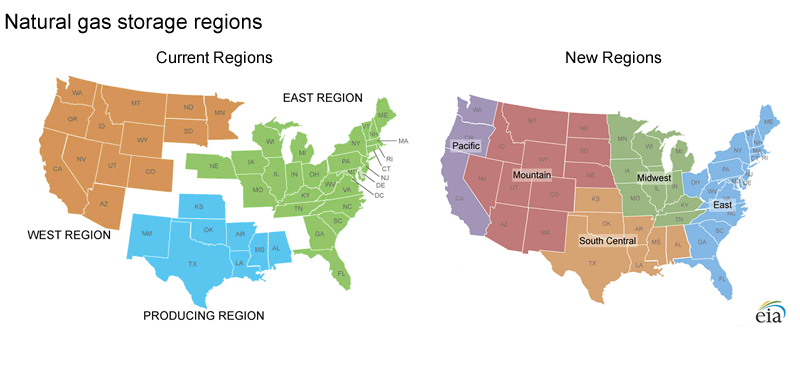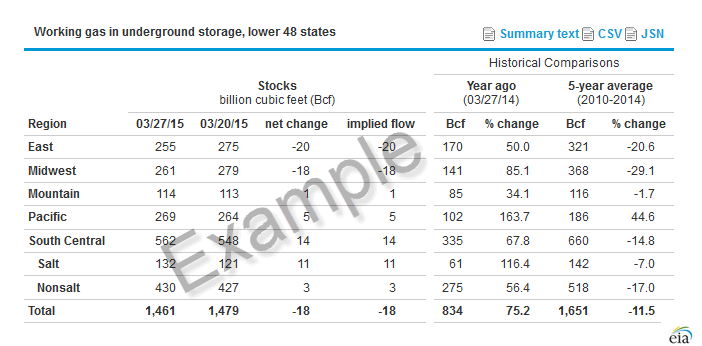‹ Weekly Natural Gas Storage Report
Notice of Changes to the Weekly Natural Gas Storage Report
Released: August 31, 2015
EIA will change the Weekly Natural Gas Storage Report regions and revision threshold
To enhance the transparency and utility of the Weekly Natural Gas Storage Report (WNGSR), the U.S. Energy Information Administration (EIA) will make several important changes later in 2015:
- The regional breakdown of the data will now include five regions for working gas in the Lower 48 states.
- The threshold for published revisions and reclassifications between working and base gas will be reduced from 7 billion cubic feet (Bcf) to 4 Bcf.
- Unscheduled release of revisions to weekly estimates of working gas held in underground storage will occur when the cumulative sum of data changes or corrections to working gas and the net change between the two most recent report weeks is at least 10 Bcf.
Regional Breakdown
EIA is updating the geographic regions for storage reporting to provide further reporting granularity and better connect the location of underground storage facilities with the markets they serve, as well as to accommodate changes in producing areas of the United States over the past several years.|
|
| Current (3) Regions | New (5) Regions |
|---|---|
|
Producing Region:
Alabama, Arkansas, Kansas, Louisiana, Mississippi, New Mexico, Oklahoma, and Texas.
East Region: Connecticut, Delaware, District of Columbia, Florida, Georgia, Illinois, Indiana, Iowa, Kentucky, Massachusetts, Maryland, Maine, Michigan, Missouri, Nebraska, New Hampshire, New Jersey, New York, North Carolina, Ohio, Pennsylvania, Rhode Island, South Carolina, Tennessee, Vermont, Virginia, Wisconsin, and West Virginia. West Region: Arizona, California, Colorado, Idaho, Minnesota, Montana, Nevada, North Dakota, Oregon, South Dakota, Utah, Washington, and Wyoming. |
South Central Region:
Alabama, Arkansas, Kansas, Louisiana, Mississippi, Oklahoma, and Texas.
East Region: Connecticut, Delaware, District of Columbia, Florida, Georgia, Massachusetts, Maryland, Maine, New Hampshire, New Jersey, New York, North Carolina, Ohio, Pennsylvania, Rhode Island, South Carolina, Vermont, Virginia, and West Virginia. Midwest Region: Illinois, Indiana, Iowa, Kentucky, Michigan, Minnesota, Missouri, and Tennessee, and Wisconsin. Mountain Region: Arizona, Colorado, Idaho, Montana, Nebraska, New Mexico, Nevada, North Dakota, South Dakota, Utah, and Wyoming. Pacific Region: California, Oregon, and Washington. |
New Historical Data
EIA has developed new historic weekly WNGSR data back to 2010 that reflect weekly estimates for the new regions. The new historical data were derived by assigning the previously submitted operator data to the new regions for the samples selected for all periods back to 2010 and assigning the related non-sample estimates to the new regions for the same period. In some cases, the weekly totals are different from previous totals by 1-2 Bcf as a result of rounding.New regional history files include:
- History by week by region
- Minimums, maximums, and averages by week by region
- Weekly to monthly differences
Data Revision Policy
Two revision policy changes affect the Weekly Natural Gas Storage Report. The first change will reduce the threshold for published revisions and reclassifications between working and base natural gas from 7 Bcf to 4 Bcf. Under the proposed revision policy, revisions will be announced in the regularly scheduled release when the sum of reported changes is at least 4 Bcf at either a regional or national level.The second change will address the unscheduled release of revisions. Under the current policy, an unscheduled release of revised data occurs when the cumulative effect of respondent-submitted data changes or when corrections are at least 10 Bcf for the current or prior report week. Under the new policy, the unscheduled release of revisions to weekly estimates of working gas held in underground storage will occur when the cumulative sum of data changes or corrections to working gas and the net change between the two most recent report weeks is at least 10 Bcf. The change leaves the 10-Bcf threshold, as well as the current out-of-cycle release procedures, intact, but it will further require that the revision have an impact of 10 Bcf or more on the reported net change between the two most recently reported weekly periods. For example, if one or more respondents submits changes totaling 10 Bcf to previously submitted data but the changes are the result of errors that have been accumulating over several weeks and do not affect flows of working natural gas into or out of storage in the most recent two reported weekly periods by more than 10 Bcf, the unscheduled data release will not occur and the revisions will be published with the next regularly scheduled release.
Implementation and Delivery
The web address for WNGSR and EIA's Gatekeeper delivery methodology will remain unchanged.Public testing of the new regional data formats will be conducted prior to the implementation of the new regions. We ask customers who normally access the data at 10:30 a.m. on Thursdays to participate to ensure automated retrieval of the information can successfully obtain the data in the new format.
The new format and revision policy will be implemented pending further internal testing and public testing of the new formats sometime later in 2015. A notice will be provided before implementation. For questions, contact Jose Villar at (202) 586-9613 or jose.villar@eia.gov.
|
|


